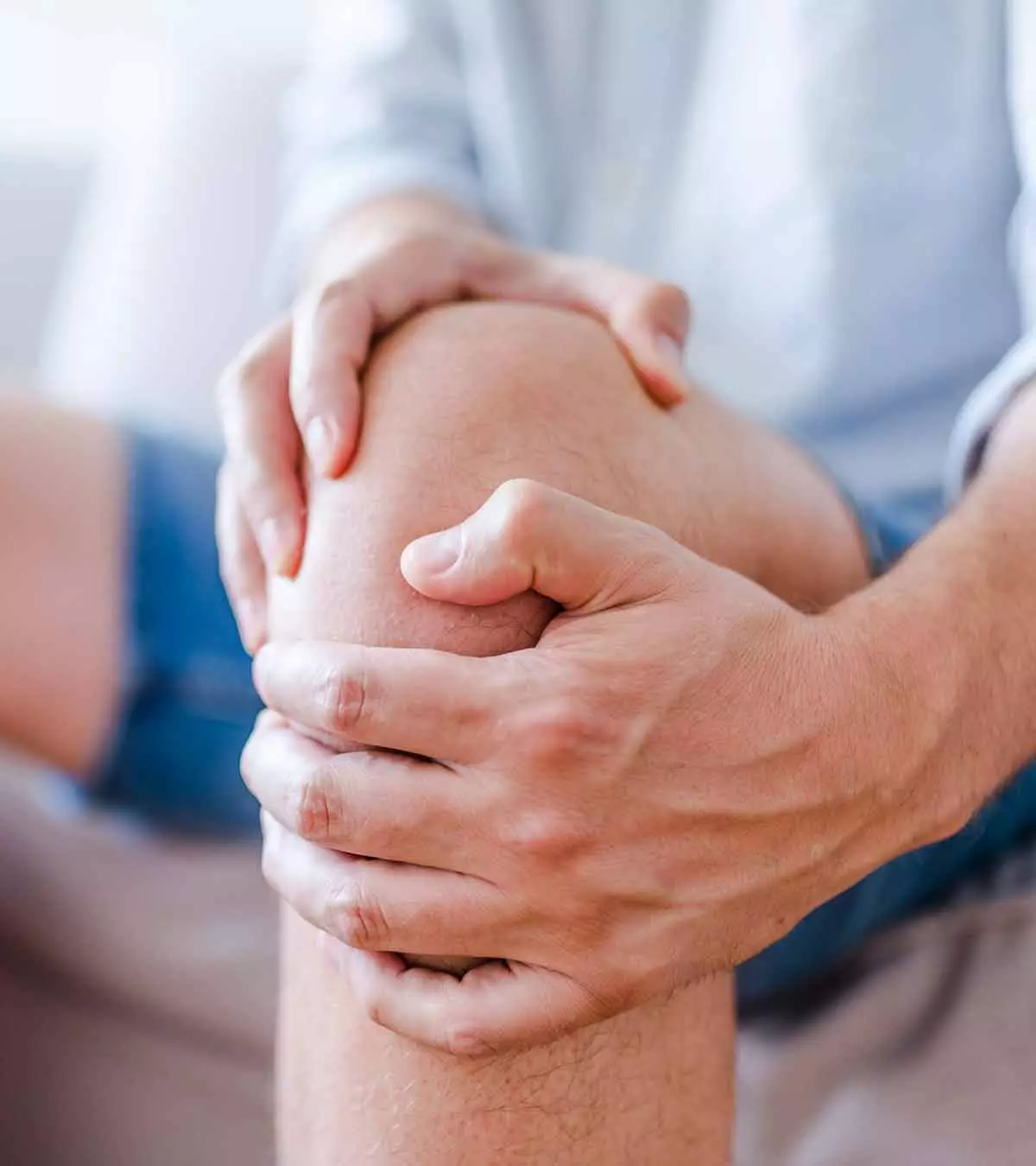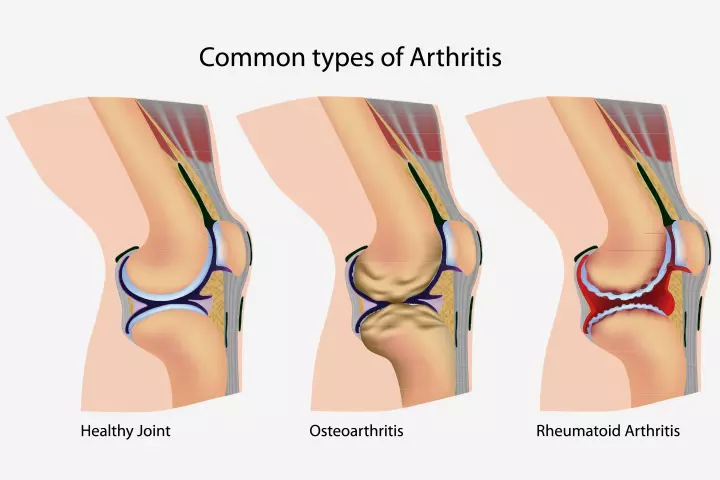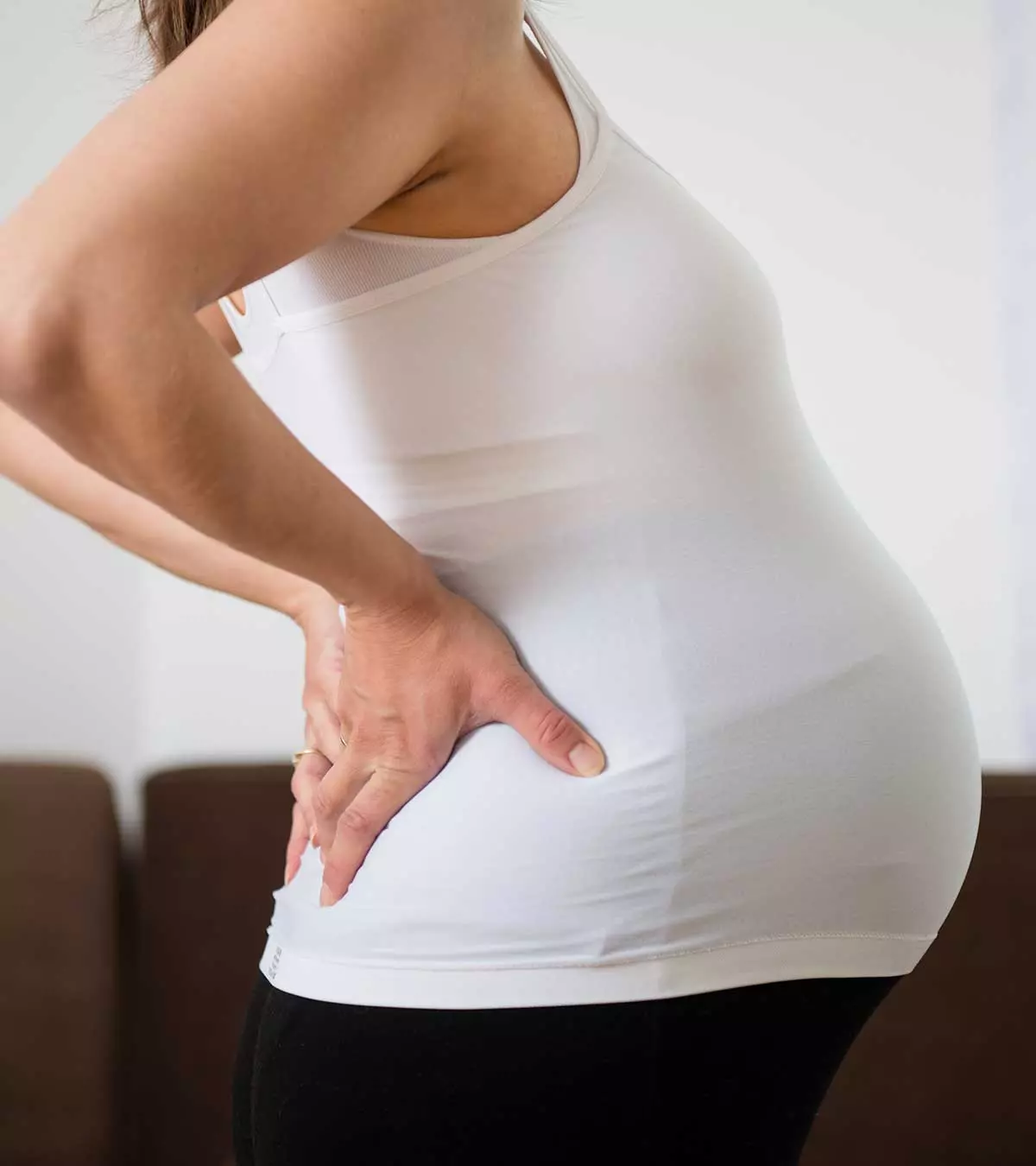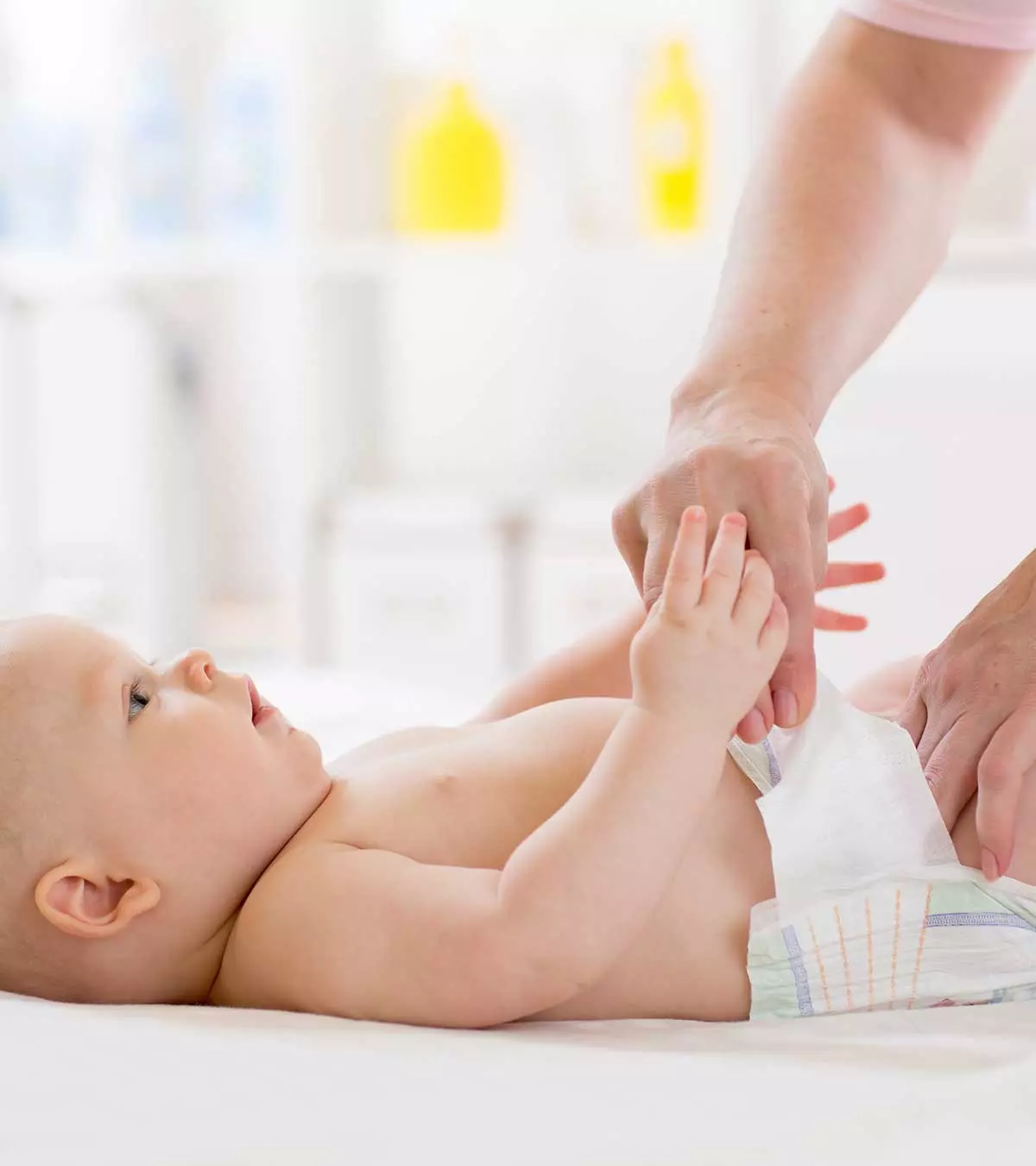

Image: Shutterstock
Arthritis in teens can cause swollen, painful, and stiff joints with loss of motion for more than six weeks in sequence. Doctors may diagnose juvenile idiopathic arthritis or juvenile rheumatoid arthritis in most teens with swollen and stiff joints with limited movement. These are autoimmune inflammatory conditions of the joints.

In the US, around 300,000 children under 18 years are diagnosed with different types of juvenile arthritis (1). If left untreated, arthritis can lead to permanent joint damages and reduced quality of life. However, effective management with early medical care and exercise may help teens cope with arthritis.
Read on to learn about types, causes, symptoms, treatment, and prevention of arthritis in teens.
Types Of Rheumatoid Or Juvenile Arthritis In Teens
Image: Shutterstock
Juvenile arthritis is of six types, each with its respective causative factors, symptoms, and prognosis (1) (2) (3).
- Oligoarticular: This arthritis type affects less than five joints, usually a knee or ankle in the body. About 50 percent of children with juvenile arthritis have this arthritis type. In most cases, the symptoms are very mild and may reduce or wane off over time.
- Polyarticular: It accounts for about 30 percent of juvenile arthritis cases. It affects five or more small or large joints, usually on both sides of the body. This arthritis type is more common in girls than boys.
- Systemic: 20 percent of the children with juvenile arthritis have systemic juvenile idiopathic arthritis. This arthritis type restricts motion in at least one joint. Its symptoms include painful joints, inflammation of organs, and high-grade fever for two weeks. If left untreated, it can affect multiple joints.
- Psoriatic: It occurs with psoriasis, a condition that causes red, scaly rashes on the skin of various parts of the body, including the face and scalp. Fingernails and toenails might also be affected by psoriasis.
- Enthesitis-related arthritis: It mostly affects entheses, the points where bones meet the tendons or ligaments. It commonly affects the knees, hips, and feet but may also affect the fingers, elbows, and lower back. It may also involve other organ systems, such as the digestive system. The condition usually appears in children between the ages of eight and 15 and is more common in boys.
- Undifferentiated arthritis. It is arthritis with symptoms that cannot be classified into a specific subtype. In this condition, inflammation can be noticed in one or more joints.
What Are The Causes Of Arthritis In Teens?
There is no known cause for juvenile arthritis. It is considered to be an autoimmune condition where the body’s immune cells attack the synovial membrane (the lining of the joint), rendering it inflamed, which, if left untreated, may cause joint damage (1) (3) (4).
Researchers believe that the intertwining of genetic and environmental factors plays a vital role in triggering the condition. Some children may have genes that make them susceptible to juvenile arthritis. These genes may emerge due to sporadic changes and may not be hereditary. Additionally, environmental factors, such as exposure to a virus, may trigger juvenile arthritis in susceptible children (5).
Signs And Symptoms Of Juvenile Arthritis
Juvenile arthritis affects each child differently. The severity of the symptoms depends on the number of joints affected. For instance, children with only a few affected joints may have no symptoms for an extended period. In contrast, children with multiple affected joints often have chronic pain, disability, and problems at school.
Below are some of the common symptoms of juvenile arthritis (3) (6).
- Stiff and painful joints, usually in the morning that improve by the afternoon
- Swelling in the joints and other body parts, such as lymph nodes
- Warm-to-touch and red joints that have limited range of motion
- Skin rashes on various parts of the body
- Recurrent sudden onset of high-grade fever
- Pain in the lower back
- Fatigue, loss of appetite, and a general feeling of sickness
A child may have some or all of these symptoms, which may recur or persist.
How Is Juvenile Arthritis Diagnosed?
Image: Shutterstock
Your doctor will collect your teens’ complete medical and family history and discuss their symptoms in detail. Based on the indications, they are likely to suggest the following tests to confirm a diagnosis (1) (2).
- Physical examination: During the physical examination, the doctor will examine your teen’s joints for signs of swelling, inflammation, and range of motion. They will also examine the muscles near the affected joints to determine signs of atrophy.
- Blood and tissue fluid tests: A blood test and tissue fluid analysis can help detect any other problem and classify the type of juvenile arthritis. Testing C-reactive protein (CRP) and erythrocyte sedimentation rate (ESR) in the blood can detect infection or inflammation. Antinuclear antibody test detects the susceptibility of a child or teen to develop an autoimmune disease.
- X-rays: X-rays can help visualize inflammation or any unusual development of the bones and joints. In some cases, the doctor may also ask for MRI and CT scan. The doctor may also refer you to an orthopedic surgeon who will further examine your teen’s joints.
Once the diagnosis is confirmed, your doctor will chart a suitable treatment plan for your teen.
Can Juvenile Arthritis Be Treated?
There is no cure for juvenile arthritis. However, treatment measures can help adequately manage the symptoms. It could also reduce or cease arthritis’ progression, alleviate swelling and pain, and improve the life’s quality.
The treatment of juvenile arthritis could consist of the following modalities (1) (2):
Nonsurgical Treatment
1. Medications
Medications will help the teen cope with the stiffness, swelling, and pain in the joints. The doctor will likely continue the medicines until the symptoms resolve and arthritis becomes inactive.
- Nonsteroidal anti-inflammatory drugs (NSAIDs), such as ibuprofen or naproxen, are a part of the first-line treatment used to alleviate inflammation and pain.
- Disease-modifying anti-rheumatic drugs (DMARDs), such as methotrexate and azulfidine, are used when NSAIDs are ineffective. DMARDs slow or cease juvenile arthritis’ progression but may take weeks or months to show results. In some cases, the doctor may advise taking DMARDs with NSAIDs.
- Biologic agents are a new drug type used when DMARDs don’t offer relief or the teen has the sacroiliac joint’s arthritis. These drugs also slow or stop the progression of the disease.
- Corticosteroids are used when the teen has severe symptoms, such as inflammation of internal organs, such as the heart. They are administered orally or intravenously. Their long-term use may cause side effects, such as growth failure, low or poor weight gain, and weakened bones.
Image: Shutterstock
2. Physical therapy
Along with medications, your doctor may advise your teen to undergo physical and occupational therapy. It is more common in teens with weaker motor skills or the inability to move and coordinate large muscle groups due to arthritis. These therapies can help improve coordination and balance and teach ways to stay active and perform daily tasks with ease. The therapist may also suggest assistive devices, such as splints and braces, that help maintain joint alignment.
3. Exercise
A physical therapist will suggest some exercises to help maintain muscle tone, and recover and preserve the joint’s range of motion and function. For instance, swimming is a good, full-body exercise that uses several joints and muscles without putting weight on them.
In addition to medication, therapy, and exercise, the doctor may suggest devices, such as electric blankets, to soothe inflamed joints. If the condition does not improve or is severe, surgical intervention may be required.
Surgical Treatment
Surgery is usually advised in severe cases with adverse complications, such as deformed joints. Your doctor will suggest the appropriate surgical procedure based on the teen’s symptoms and the joints affected. Ensure you follow the directed post-operative care for your child’s full recovery.
What Are The Possible Complications Of Juvenile Arthritis?
Severe untreated juvenile arthritis may lead to the following complications (3) (7).
- Permanent damage of the joint tissues
- Joint contracture (a permanent contraction of a joint)
- Permanent loss of joint’s motion
- Uneven growth of muscles or bones
- Osteoporosis
- Muscle loss
- Slow growth
- Vision problems
- Anemia
- Pericarditis (swelling around the heart)
Besides these, juvenile arthritis could affect the overall quality of a teen’s life to the extent that they may develop low self-esteem and depression.
Is Juvenile Arthritis Preventable?
There is no way to prevent juvenile arthritis since it does not have a specific cause.
If your teen has arthritis, you may prevent the worsening of symptoms and improve the quality of life through the following ways (8).
- Help your teen follow their medications and physical therapy religiously. Explain to them that the treatment is vital to relieve pain and avert complications.
- Motivate them to exercise as directed by the doctor. Some teens may feel that exercise makes their symptoms worse. On the contrary, exercise can help preserve and recover lost joint and muscle strength and function.
- Consult a nutritionist and feed your teen a well-balanced diet. You can include whole grains, whole fruits, vegetables, fatty fish, nuts, and seeds, rich in antioxidants that could help counteract inflammation.
- Boost your teen’s self-esteem. Encourage them to attend school, play sports, and regularly participate in extracurricular and family activities.
- Check with your doctor about pain-relieving topical products, such as creams, gels, or stick-on patches to ease the pain in a joint or muscle.
- Consult your doctor about alternative remedies, such as hot pads and cold pads. While hot pads work best for soothing stiff joints and tired muscles, cold pads are suitable to reduce acute pain.
- Try different ways to relax the mind and the body to stop focusing on pain. Meditation, deep breathing, and positive visualization are some ways to divert the teen’s mind from the pain and make them feel better.
- Enquire about massage and acupuncture. These alternative healthcare modalities may help reduce pain and ease stress or anxiety. Speak to your child’s doctor before trying them out.
- Guide your teen to balance activity with rest. A combination of light activity with rest can help reduce inflammation, protect joints, and preserve energy.
- Know if your teen can take some supplements, such as curcumin and omega-3 fish oil, to reduce joint pain and stiffness. Also, check about calcium and vitamin D supplements that can help build strong bones. Checking about supplements with a doctor is vital to prevent drug interaction.
Frequently Asked Questions
1. Can a teen live a normal life with arthritis?
If treated appropriately, teens with arthritis can attend academic classes and have good long-term outcomes. Teens with juvenile arthritis may have limitations participating in certain physical and sports activities if they have pain or other arthritis symptoms. Usually, they can participate in these activities when the symptoms are under control (9).
2. Does arthritis come on suddenly?
According to the US Centers For Disease Control And Prevention (CDC), arthritis symptoms can develop suddenly or gradually over time, depending on the type of arthritis. Some may have arthritis symptoms for a shorter period, while it can persist for longer in some (10).
Juvenile arthritis or arthritis in teens is not uncommon. It can affect more than one joint in your teen’s body. The overall condition of the teen depends on the number of joints affected and the severity of the condition. Some teens may be unaffected. Unfortunately, there is no permanent cure for the condition. However, treatment can manage the symptoms to improve the quality of your teen’s life. Ensure to stand with your teen as the condition may lead to anxiety or depression.
Key Pointers
- Juvenile rheumatoid arthritis is the most common type of arthritis in children below 16.
- Research suggests that environmental factors entwined with genetic factors play a significant role in causing arthritis in children.
- Stiff and painful joints, fatigue, redness are common symptoms of this condition.
- Medications and physical therapy can help manage the symptoms of arthritis.
References
1. Juvenile Arthritis; American Academy of Orthopaedic Surgeons
2. Juvenile Idiopathic Arthritis; Kids Health From Nemours
3. Juvenile idiopathic arthritis; Medline Plus
4. Juvenile Arthritis; American College of Rheumatology
5. Juvenile Rheumatoid Arthritis (JRA) Causes; Stanford Healthcare
6. Juvenile Rheumatoid Arthritis Symptoms; Stanford Healthcare
7. Complications of juvenile idiopathic arthritis; About Kids Health
8. Juvenile Idiopathic Arthritis (JIA); Arthritis Foundation
9. Juvenile Arthritis; OrthoInfo
10. Facts About Arthritis; US CDC
Community Experiences
Join the conversation and become a part of our nurturing community! Share your stories, experiences, and insights to connect with fellow parents.
Read full bio of Dr. Richard Mario Lurshay
Read full bio of Swati Patwal

















